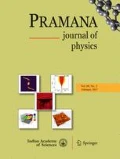Abstract
The Karolyhazy uncertainty relation states that if a device is used to measure a length l, there will be a minimum uncertainty \(\delta l\) in the measurement, given by \((\delta l)^3 \sim L_{\mathrm {P}}^2 l\). This is a consequence of combining the principles of quantum mechanics and general relativity. In this letter we show how this relation arises in our approach to quantum gravity, in a bottom-up fashion, from the matrix dynamics of atoms of space–time–matter. We use this relation to define a space–time–matter (STM) foam at the Planck scale, and to argue that our theory is holographic. By coarse graining over time-scales larger than Planck time, one obtains the laws of quantum gravity. Quantum gravity is not a Planck scale phenomenon; rather it comes into play whenever classical space–time background is not available to describe a quantum system. Space–time and classical general relativity arise from spontaneous localisation in a highly entangled quantum gravitational system. The Karolyhazy relation continues to hold in the emergent theory. An experimental confirmation of this relation will constitute a definitive test of the quantum nature of gravity.

Similar content being viewed by others
References
F Karolyhazy, Nuovo Cimento A 42, 390 (1966)
F Karolyhazy, A Frenkel and B Lukács, On the possible role of gravity in the reduction of the wave function, in: Quantum concepts in space and time edited by R Penrose and C J Isham (Clarendon, Oxford, 1986)
A Bassi, K Lochan, S Satin, T P Singh and H Ulbricht, Rev. Mod. Phys. 85, 471 (2013), arXiv:1204.4325 [quant-ph]
Y J Ng and H van Dam, Mod. Phy. Letts. A 3, 335 (1994)
Y J Ng and H van Dam, Mod. Phy. Letts. A 10, 2801 (1995)
N Sasakura, Prog. Theor. Phys. 102, 169 (1999)
Y J Ng, Entropy 21, https://doi.org/10.3390/e21111035, arXiv:1910.00040 v1 [gr-qc] (2019)
G Amelino-Camelia, Nature 398, 216 (1999)
Y J Ng, Phys. Rev. Lett. 86, 2946 (2001)
M Palemkota and T P Singh, Z. Naturforsch. A 75, 143 (2019), https://doi.org/10.1515/zna-2019-0267arXiv:1908.04309
S L Adler, Quantum theory as an emergent phenomenon (Cambridge University Press, Cambridge, 2004)
T P Singh, Int. J. Mod. Phys. https://doi.org/10.1142/S0218271820430129 (2020)
T P Singh, Z. Naturforsch. https://doi.org/10.1515/zna-2020-0196 (2020)
M S Meghraj, A Pandey and T P Singh (submitted for publication), arXiv:2006.05392 (2020)
T P Singh, Z. Naturforsch. https://doi.org/10.1515/zna-2020-0255 (2020)
M Palemkota and T P Singh, arXiv:1909.02434v2 [gr-qc] (2019) (submitted for publication)
T P Singh, Z. Naturforsch. A 74, 617 (2019), https://doi.org/10.1515-zna-2019-0079, arXiv:1903.05402
S Vermeulen, L Aiello, A Ejlli, W Griffiths, A James, K Dooley and H Grote, arXiv:2008.04957 (2020)
T P Singh, Z. Naturforsch. https://doi.org/10.1515/zna-2020-0073, arXiv:1909.06340 [gr-qc] (2020)
Acknowledgements
The author would like to thank Maithresh Palemkota, Hendrik Ulbricht and Daniel Goldwater for useful discussions, which have also contributed to some of the ideas in this paper.
Author information
Authors and Affiliations
Corresponding author
Rights and permissions
About this article
Cite this article
Singh, T.P. Quantum gravity, minimum length and holography. Pramana - J Phys 95, 40 (2021). https://doi.org/10.1007/s12043-020-02052-2
Received:
Revised:
Accepted:
Published:
DOI: https://doi.org/10.1007/s12043-020-02052-2




